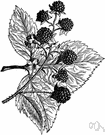apomict
(redirected from apomicts)Also found in: Thesaurus, Medical.
ap·o·mict
(ăp′ə-mĭkt′)n.
A plant that reproduces or is reproduced by apomixis.
[Back-formation from apomictic, produced by apomixis : apo- + Greek miktos, mixed (from meignunai, mig-, to mix; see apomixis).]
ap′o·mic′tic adj.
ap′o·mic′tic·al·ly adv.
American Heritage® Dictionary of the English Language, Fifth Edition. Copyright © 2016 by Houghton Mifflin Harcourt Publishing Company. Published by Houghton Mifflin Harcourt Publishing Company. All rights reserved.
apomict
(ˈæpəˌmɪkt)n
(Biology) an organism, esp a plant, produced by apomixis
Collins English Dictionary – Complete and Unabridged, 12th Edition 2014 © HarperCollins Publishers 1991, 1994, 1998, 2000, 2003, 2006, 2007, 2009, 2011, 2014
ap•o•mict
(ˈæp ə mɪkt)n.
an organism produced by apomixis.
[1935]
Random House Kernerman Webster's College Dictionary, © 2010 K Dictionaries Ltd. Copyright 2005, 1997, 1991 by Random House, Inc. All rights reserved.
ThesaurusAntonymsRelated WordsSynonymsLegend:
Switch to new thesaurus
| Noun | 1. |  apomict - a plant that reproduces or is reproduced by apomixis apomict - a plant that reproduces or is reproduced by apomixis |
Based on WordNet 3.0, Farlex clipart collection. © 2003-2012 Princeton University, Farlex Inc.